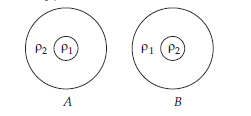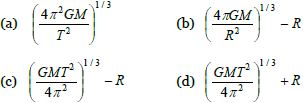Refer to CBSE Class 9 Science Gravitation MCQs Set D provided below available for download in Pdf. The MCQ Questions for Class 9 Science with answers are aligned as per the latest syllabus and exam pattern suggested by CBSE, NCERT and KVS. Chapter 9 Gravitation Class 9 MCQ are an important part of exams for Class 9 Science and if practiced properly can help you to improve your understanding and get higher marks. Refer to more Chapter-wise MCQs for CBSE Class 9 Science and also download more latest study material for all subjects
MCQ for Class 9 Science Chapter 9 Gravitation
Class 9 Science students should refer to the following multiple-choice questions with answers for Chapter 9 Gravitation in Class 9.
Chapter 9 Gravitation MCQ Questions Class 9 Science with Answers
Question: The value of G was first determined experimentally by
a) Newton
b) Henry Cavendish
c) Kepler
d) Galileo
Answer: c
Question: Where will it be profitable to purchase one kilogram of apples?
a) At poles
b) At equator
c) At 45° latitudes
d) at 60° latitude
Answer: b
Question: The acceleration due to gravity
a) has the same value everywhere in space.
b) has the same value everywhere on the earth.
c) varies with the latitude on the earth.
d) is greater on the moon.
Answer: c
Question: A ball is dropped from a spacecraft revolving around the earth at a height of 120 km. What will happen to the ball
a) It will continue to move with velocity v along the original orbit of spacecraft
b) It will move with the same speed tangentially to the spacecraft
c) It will fall down to the earth gradually
d) It will go very far in the space
Answer: a
Question: Particles of masses 2M, m and M are respectively at points A, B and C with AB = 1/2(BC). m is much-much smaller than M and at time t = 0, they are all at rest. At subsequent times before any collision takes place
![]()
a) m will remain at rest.
b) m will move towards M.
c) m will move towards 2M.
d) m will have oscillatory motion.
Answer: c
Question: Which is wrong statement about acceleration due to gravity?
a) Its value is 9.8 m/s2
b) It is zero at the centre of the earth.
c) Its value changes from place to place.
d) It is a scalar quantity.
Answer: d
Question: Acceleration due to gravity on the moon is of that on the earth.
a) 1/6th
b) 1/3rd
c) 1/4th
d) 1/5th
Answer: a
Question: Two identical satellites are at R and 7R away from earth surface, the wrong statement is (R = Radius of earth)
a) Ratio of total energy will be 4
b) Ratio of kinetic energies will be 4
c) Ratio of potential energies will be 4
d) Ratio of total energy will be 4 but ratio of potential and kinetic energies will be 2
Answer: d
Question: The mass of a body is increased 4 fold and mass of other body is increased 16 fold) How should the distance between them be changed to keep the same gravitational force between them?
a) 4 times
b)1/4 times
c) 8 times
d) 1/8 times
Answer: c
Question: An astronaut in the orbit in a spacecraft feels weightlessness
a) due to the absence of gravity inside
b) due to the fact that spacecraft has no energy
c) because acceleration in the orbit is equal to acceleration of gravity outside
d) there is no gravity outside
Answer: c
Question: The value of universal gravitational constant was first determined experimentally by
a) Newton.
b) Galileo.
c) Cavendish.
d) Einstein.
Answer: c
Question: When a body is dropped from a certain height, acceleration due to gravity is taken as
a) + 9.8 m/s2
b) –9.8 m/s2
c) 0
d) + 9.8 m/s
Answer: a
Question: The gravitational force of attraction between the earth and the moon is
a) 2.22 × 1020 N
b) 2.02 × 1020 N
c) 2.02 × 1010 N
d) 3.02 × 1020 N
Answer: b
Question: When the distance between the two objects is reduced to half, the force of gravitation becomes of the initial value.
a) ½
b) thrice
c) ¼
d) 4 times
Answer: d
Question: The accepted value of G is
a) 6.674 × 10–11 Nm2/kg2
b) 5.674 × 10–11 Nm2/kg2
c) 6.674 × 10–10 Nm2/kg2
d) 6.674 × 10–11 Nm2/kg
Answer: a
Question: An artificial satellite is placed into a circular orbit around earth at such a height that it always remains above a definite place on the surface of earth. Its height from the surface of earth is
a) 6400 km
b) 4800 km
c) 32000 km
d) 36000 km
Answer: d
Question: Two planets A and B of same mass and same radius are shown in the figure. p1 and p2 are densities of the materials in the planets and p1 > p2. If the accelerations due to gravity on the surfaces of the planets A and B are gA and gB respectively, then

a) gA = gB
b) gA < gB
c) gA > gB
d) Given information is not sufficient
Answer: a
Question: The equation F = Gm1m2/r2 is valid for
a) rectangular bodies
b) circular bodies
c) elliptical bodies
d) spherical bodies
Answer: d
Question: The orbital velocity of a planet revolving close to earth's surface is
a) √2gR
b) √gR
c) √2g/R
d) √g/R
Answer: b
Question: When the masses of two objects are doubled, the force of gravitation between them becomes the original value.
a) 4 times
b) double
c) 5 times
d) 8 times
Answer: a
Question: Two satellites A and B go round a planet P in circular orbits having radii 4R and R respectively. If the speed of the satellite A is 3V, the speed of the satellite B will be.
a) 12 V
b) 6 V
c) 4/3 V
d) 3/2 V
Answer: b
Question: If g0, gh and gd be the acceleration due to gravity at earth’s surface, at height h and at a depth d respectively, then
a) g0 > gh and g0 > gd
b) g0 < gh and g0 < gd
c) g0 > gh and g0 < gd
d) g0 < gh and g0 > gd
Answer: a
Question: A satellite moves round the earth in a circular orbit of radius R making one revolution per day. A second satellite moving in a circular orbit, moves round the earth once in 8 days. The radius of the orbit of the second satellite is
a) 8 R
b) 4R
c) 2R
d) R
Answer: b
Question: If satellite is shifted towards the earth. Then time period of satellite will be
a) Increase
b) Decrease
c) Unchanged
d) Nothing can be said
Answer: b
Question: particles each of mass m are kept at vertices of an equilateral triangle of side L. The gravitational field at centre due to these particles is
a) Zero
b) 23LGM
c) 29LGM
d) 2312LGM
Answer: a
Question: Given radius of Earth ‘R’ and length of a day ‘T’ the height of a geostationary satellite is [G–Gravitational Constant, M–Mass of Earth]

Answer: c
Question: If R is the radius of the earth, the height at which the weight of a body becomes ¼ its weight on the surface of the earth is
a) 2R
b) R
c) R/2
d) R/4
Answer: b
Question: When the distance between the two objects is doubled, the force of gravitation becomes of the initial value.
a) 4 times
b) ¼
c) double
d) ½
Answer: b
Question: The time period of a satellite of earth is 5 hours. If the separation between the earth and the satellite is increased to four times the previous value, the new time period will become
a) 20 hours
b) 10 hours
c) 80 hours
d) 40 hours
Answer: d
Question: Which of the following statements is/are correct?
I. Mass of an object is the measure of its inertia
II. Heavier the object smaller is the inertia
III. The mass of an object is variable.
a) Only I
b) I and III
c) II and III
d) I and II
Answer: a
| CBSE Class 9 Science Atoms and Molecules MCQs Set A |
| CBSE Class 9 Science Atoms and Molecules MCQs Set B |
| CBSE Class 9 Science Atoms and Molecules MCQs Set C |
| CBSE Class 9 Science Animal Tissues MCQs |
| CBSE Class 9 Science Tissue MCQs Set A |
| CBSE Class 9 Science Tissue MCQs Set B |
| CBSE Class 9 Science Tissue MCQs Set C |
| CBSE Class 9 Science Motion MCQs Set A |
| CBSE Class 9 Science Motion MCQs Set B |
| CBSE Class 9 Science Motion MCQs Set C |
| CBSE Class 9 Science Motion MCQs Set D |
| CBSE Class 9 Science Work and Energy MCQs Set A |
| CBSE Class 9 Science Work and Energy MCQs Set B |
| CBSE Class 9 Science Work and Energy MCQs Set C |
| CBSE Class 9 Science Sound MCQs Set A |
| CBSE Class 9 Science Sound MCQs Set B |
| CBSE Class 9 Science Sound MCQs Set C |
| CBSE Class 9 Science Improvement In Food Resources MCQs Set A |
| CBSE Class 9 Science Improvement In Food Resources MCQs Set B |
MCQs for Chapter 9 Gravitation Science Class 9
Expert teachers of studiestoday have referred to NCERT book for Class 9 Science to develop the Science Class 9 MCQs. If you download MCQs with answers for the above chapter you will get higher and better marks in Class 9 test and exams in the current year as you will be able to have stronger understanding of all concepts. Daily Multiple Choice Questions practice of Science will help students to have stronger understanding of all concepts and also make them expert on all critical topics. After solving the questions given in the MCQs which have been developed as per latest books also refer to the NCERT solutions for Class 9 Science. We have also provided lot of MCQ questions for Class 9 Science so that you can solve questions relating to all topics given in each chapter. After solving these you should also refer to Class 9 Science MCQ Test for the same chapter.
You can download the CBSE MCQs for Class 9 Science Chapter 9 Gravitation for latest session from StudiesToday.com
Yes, the MCQs issued by CBSE for Class 9 Science Chapter 9 Gravitation have been made available here for latest academic session
You can find CBSE Class 9 Science Chapter 9 Gravitation MCQs on educational websites like studiestoday.com, online tutoring platforms, and in sample question papers provided on this website.
To prepare for Chapter 9 Gravitation MCQs, refer to the concepts links provided by our teachers and download sample papers for free.
Yes, there are many online resources that we have provided on studiestoday.com available such as practice worksheets, question papers, and online tests for learning MCQs for Class 9 Science Chapter 9 Gravitation

